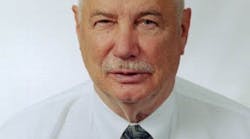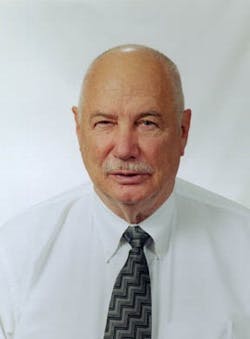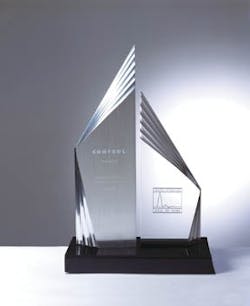If it wasn't for a football injury, this year's third Hall of Famer might have been running for the Green Bay Packers in the first Super Bowl in 1967, not rewriting model predictive control.
But a second fracture in his right leg made Charles Cutler realize football was ephemeral, and chemical engineering would at least be less crippling. After a second try at studies at Lamar University, Cutler graduated in 1961 and went to work for Shell Oil Co. There he would conceive and implement the concept of a dynamic matrix control (DMC) algorithm, which would save the petrochemical industry millions of dollars.
"Clearly, the problems that DMC solved and the benefit it has had on the welfare of the process industry allows it to be rated as a revolution in technology," says R. Russell Rhinehart, head of the School of Chemical Engineering at Oklahoma State University. "It was Charlie's particular innovative ability, interpersonal skills, persistence, and leadership that generated the worldwide acceptance of DMC."
Wrong Hall of Fame?
On a football scholarship to Lamar University, Charles Cutler was the leading ground gainer in his conference until he broke his leg in a game. He had an offer to try out for the Green Bay Packers.
"I was in the right place at the right time," Cutler, now 66, says of his arrival at Shell. "I was only there a year when they decided to try out computerized process control. We would take a linear process, perturb it, take the derivative, and repeat the whole process, using a successive linear process."
In 1963, Shell transferred him from the Houston refinery to a research group that was assigned to optimize and control a fluid catalytic cracking unit. While the real-time optimization was worked out, "the optimization used up all its degrees of freedom at some combination of constraints, which meant the PID controllers had to operate at multiple constraints. The optimum operation couldn't be reached because the controller would cycle around the setpoint in coming to steady state."
Even after working on that problem for several years with other engineers at Shell, the dilemma vexed him. It was one of the reasons he entered graduate school--"to see if I could find a way to control at multiple constraints. While taking a course in Z transforms, it occurred to me that if you truncate the infinite series of Z transforms and evaluate each term in the series, the process dynamics could be represented by a set of linear equations that are a function of time. These equations could in turn be put into a linear program that could handle constraints on the dynamics."
This was the budding theory of dynamic matrix control (DMC). It was the subject of his dissertation in 1967 and was demonstrated on a fluid catalytic cracking unit six years later in Shell's New Orleans refinery.
Cutler was implementing a computerized control system based on his DMC theory when the plant's union went on strike. Shell decided to run the refinery with non-union staff. "The computer was optimizing and controlling the unit at the time we took over. I decided to see how well the controller would perform with no intervention from the operators. It ran for five weeks with zero intervention."
Five weeks into the strike and locked in the refinery, Cutler decided to write a program to demonstrate the DMC algorithm. "The program did not consider constraints. It was written to use an error minimization calculation to hold the process at the setpoint and reject disturbances. The basic control was adjusting the fuel to the preheat furnace on the FCC to control the outlet temperature, while looking at disturbances in the fuel gas quality, changes in the stack damper, feed rate, and feed inlet temperature. The controller was a great success." At least under normal operating conditions.
Then the cracker lost a feedpump. "The inlet temperature dropped 75* [DEG] in 10 minutes, which would have really torn up the cracker. The controller saw the disturbance coming and adjusted the fuel in such a way that resulted in a 2-3* [DEG] drop in the furnace outlet temperature. The normal drop with a PID controller would have been 25-30* [DEG]."
Read Also: Cascade, Scan Time, PID Tuning
This experience led to the publication of Cutler's seminal paper with Brian Ramaker, "Dynamic Matrix Control-A Computer Control Algorithm," presented at the national meeting of the American Institute of Chemical Engineers in 1979.
Charles Cutler and his son-in-law Chuck Johnston (left)
Running in Manual
Charles Cutler may have been at the helm in the creation of two engineering firms, but his son-in-law Chuck Johnston (left) was right behind him in each case.
Cutler was eventually given management oversight of all the control systems at Shell, optimizing numerous processes and saving the company tons of money. Dynamic matrix control became the standard method of controlling complex processes at Shell during the late 1970s and early '80s.
Even though he already was thinking that he had a commercially viable product on his hands, the lack of computing power kept DMC and Cutler captive to Shell. Each implementation was a hand-built, separate controller. "My goal was to make a generic controller that could be configured for each application. It would be easier to install and maintain.
"But the computers of the time wouldn't let us solve real multivariable problems," Cutler says. "We had to wait for computers with more horsepower. Now we do matrices of 10,000 x 100,000. We started out with 40 x 40. By the early '80s, we had computers that were reasonably good number crunchers, so I decided we could commercialize." By the time Cutler left, Shell had more than 200 implementations of DMC.
DMC Becomes a Company
Cutler and Chuck Johnston resigned from Shell and founded Dynamic Matrix Control Corp. in June 1984, working out of the Cutler townhouse. The Johnstons moved in next door. It was two years before the first commercial software to configure a multivariable controller became available with the DMC controller software.
Now in its third year, the CONTROL Process Automation Hall of Fame honors "excellence, diligence, and influence" in the fields of process control, instrumentation, and automation. Inductees preceding Charles Cutler are Karl Astrom, Lynn Craig, Marion "Bud" Keyes, Bela Liptak, Greg McMillan, Greg Shinskey, Terry Tolliver, and Harold Wade.
In 1986, a DMC controller was installed on a Sunoco hydrocracker. "The first time the controller was turned on, the optimizer reduced the energy usage 15%," he recalls with obvious pride. Soon, every petroleum company had to have DMC. Texaco engineers once said in a technical presentation that DMC was saving $15,000-25,000 a day at the Port Arthur, Texas, refinery alone."This was the first time theory and standard software came together in such a way that all the practical, real-world issues of implementing [multivariable process control] on major process units were dealt with effectively," says Ronald Sorensen, consulting engineer in process control and optimization at Chevron Research & Technology Co., Richmond, Calif.
DMCC was an engineering-driven company built on the philosophy that customers must be satisfied, and the best way to do that was to "continue to work on a project until the customer was convinced we were making them money," Cutler says. Though the financial success of his customers was first in his mind, Cutler remained driven by the need to solve problems.
In 1995, he realized his company's software needed a more user-friendly interface to remain competitive, and he thought of partnering with a simulation company to provide it. In 1996, Houston-based Aspen Technology not only provided the interface but suggested a merger, and Cutler decided to sell.
He worked for Aspen for two years after the sale, then retired,temporarily,to his ranch in west Texas. But his thoughts turned again to control and to solving a problem that he helped create. "One of the problems created by a large DMC controller is the loss of operator skills in operating the process. I thought of ways to use the DMC controller as a training simulator."
So in 2000 he again teamed with Johnston to create Cutler Johnston Corp. Aspen Tech helped create the graphical user interface. Two years of development later, the Universal Process Identification (UPID) resulted. "It permits the creation of an open loop model (all-valve model) that can be used by a training simulator. The software permits a unit to be tested with one PID configuration and later changed to another."
In March, he moved Cutler Johnston from Houston to the west Texas ranch, where Cutler can continue to consult and work with the UPID--as well as enjoy his grandchildren.

Leaders relevant to this article:






